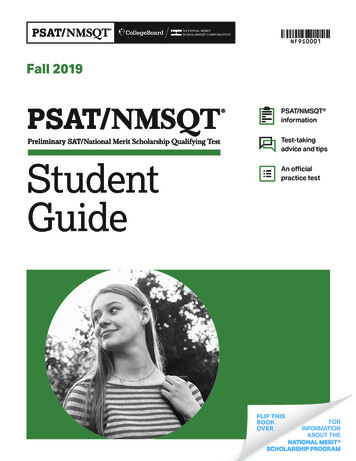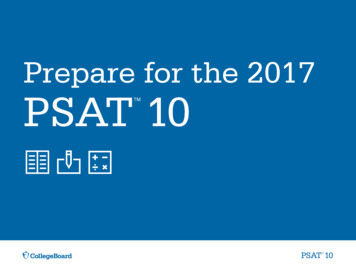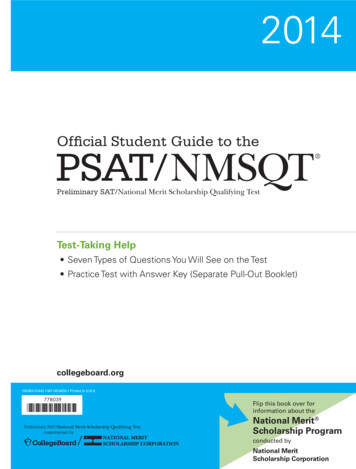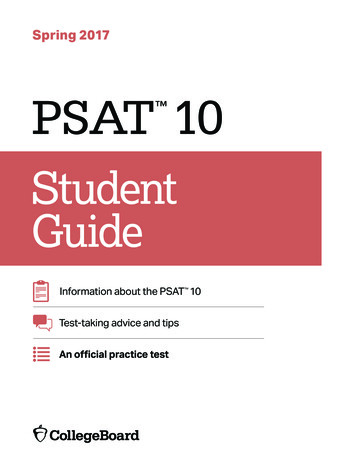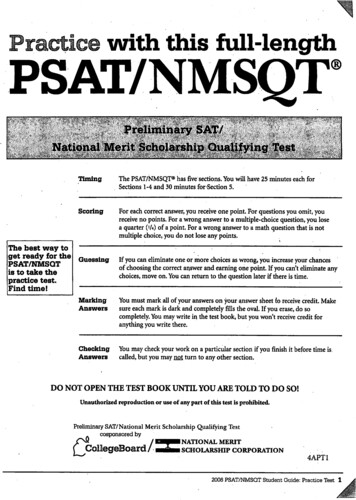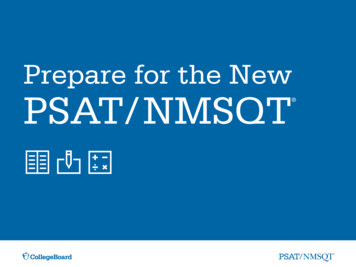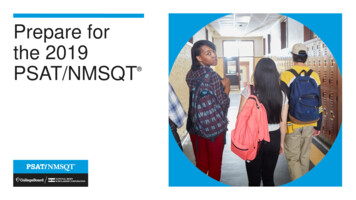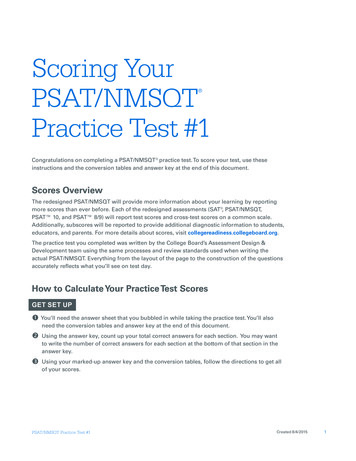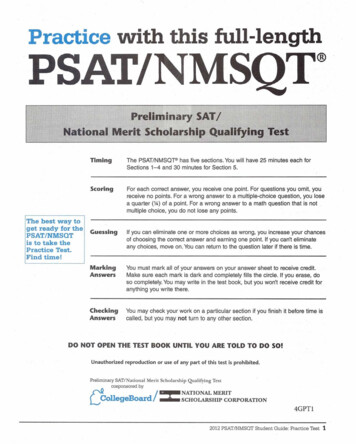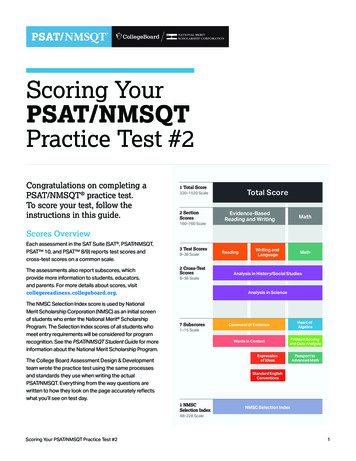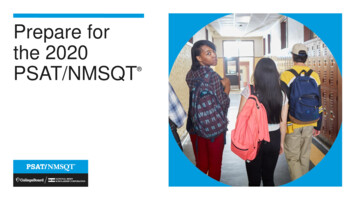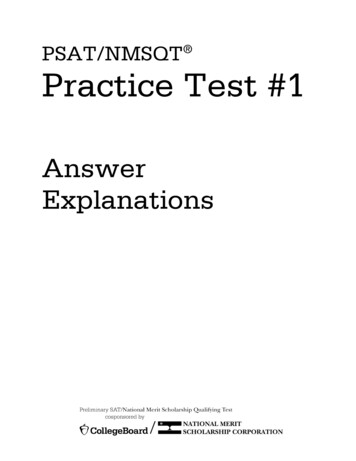
Transcription
PSAT/NMSQT Practice Test #1AnswerExplanations
Table of Contents:Reading Test Answer Explanations . 1Writing and Language Test Answer Explanations . 29Math Test – No Calculator Answer Explanations . 52Math Test – Calculator Answer Explanations . 66Answer Key .93User Notes:Please have a copy of the PSAT/NMSQT Practice Test #1 to reference for thepassages and other information that form the basis for the questions in theEvidence-Based Reading and Writing and the Math sections of the Practice Test.You can also refer to the test to see the information given to students about mathformulas and how to record the student-produced responses.In this document, we have provided the following for each question: difficulty level content description best or correct answer answer explanation 2015 The College Board. PSAT/NMSQT is a registered trademark of the College Board and NationalMerit Scholarship Corporation. All other products and services may be trademarks of their respectiveowners. Visit the College Board on the Web: www.collegeboard.org.
PSAT/NMSQT Practice Test #1Reading Test Answer ExplanationsReading Test Answer ExplanationsQuestion 1The main purpose of the passage is to(A)describe a main character and a significant change in her life.(B)provide an overview of a family and a nearby neighbor.(C)discuss some regrettable personality flaws in a main character.(D) explain the relationship between a main character and her father.Item Difficulty: EasyContent: Rhetoric / Analyzing purposeBest Answer: AChoice A is the best answer. Emma Woodhouse’s life and family are discussed,including the marriage of her governess Miss Taylor who then moves out ofEmma’s home. In line 74, Emma wonders how she is to “bear the change” of MissTaylor’s departure, which indicates its significance.Choices B and D are incorrect because the passage focuses more on Emma thanon her family and neighbors, and Emma’s relationship with her father is arelatively minor consideration. Choice C is also incorrect because Emma ischaracterized as handsome and clever with a happy disposition, and her arroganceis only briefly mentioned.Question 2Which choice best summarizes the first two paragraphs of the passage(lines 1-14)?(A)Even though a character loses a parent at an early age, she ishappily raised in a loving home.(B)An affectionate governess helps a character to overcome the loss ofher mother, despite the indifference of her father.(C)Largely as a result of her father’s wealth and affection, a characterleads a contented life.(D) A character has a generally comfortable and fulfilling life, but thenshe must recover from losing her mother.Item Difficulty: HardContent: Information and Ideas / SummarizingBest Answer: APage 1
PSAT/NMSQT Practice Test #1Reading Test Answer ExplanationsChoice A is the best answer. The passage indicates that Emma’s mother died longago and that Emma barely remembers her. Emma is raised by an affectionatefather and governess and is described as a person with a happy disposition.Choices B, C, and D are incorrect: Emma's father is not described as indifferent,Emma is not described as contented because of her father’s wealth, and Emmadoes not appear to suffer from the loss of her mother.Question 3The narrator indicates that the particular nature of Emma’s upbringingresulted in her .(D) inconsiderate.Item Difficulty: MediumContent: Information and Ideas / Reading closelyBest Answer: BChoice B is the best answer. According to the passage, Emma had “a dispositionto think a little too well of herself” (line 30). Thinking a “little too well of herself”means that Emma had an elevated opinion of herself, or that she was selfsatisfied.Choices A, C, and D are incorrect because Emma’s relationship with her father andMiss Taylor, the two characters who raised her, did not result in her beingdespondent, friendless, or inconsiderate.Question 4Which choice provides the best evidence for the answer to the previousquestion?(A) Lines 1-5 (“Emma . . . her”)(B) Lines 9-14 (“Her . . . affection”)(C) Lines 28-32 (“The real . . . enjoyments”)(D) Lines 32-34 (“The danger . . . her”)Item Difficulty: MediumContent: Information and Ideas / Citing textual evidenceBest Answer: CChoice C is the best answer. Lines 28-32 state that “The real evils indeed ofEmma’s situation were the power of having rather too much her own way, and aPage 2
Reading Test Answer ExplanationsPSAT/NMSQT Practice Test #1disposition to think a little too well of herself; these were the disadvantages whichthreatened alloy to her many enjoyments.” Thinking a “little too well of herself”means that Emma had an elevated opinion of herself, or that she was selfsatisfied.Choices A, B, and D are incorrect because they do not provide the best evidencefor Emma being self-satisfied. Choice A describes Emma’s positive traits, choice Bdescribes Emma’s affectionate relationship with Miss Taylor, and choice Ddiscusses only that Emma’s problems were negligible.Question 5As used in line 26, “directed” most nearly means(A)trained.(B)aimed.(C)guided.(D) addressed.Item Difficulty: MediumContent: Information and Ideas / Interpreting words and phrases in contextBest Answer: CChoice C is the best answer. In lines 25-27, Emma’s situation is described as“doing just what she liked; highly esteeming Miss Taylor’s judgment, but directedchiefly by her own.” In other words, Emma respects Miss Taylor’s opinion butmakes decisions directed, or guided, primarily by her own opinion.Choices A, B, and D are incorrect because lines 25-27 emphasize that in “doingwhat she liked” Emma was directed, or guided, by her own opinion. Emma’sopinion is not trained by, aimed at, or addressed by anyone else.Question 6As used in line 54, “want” most nearly means(A)desire.(B)lack.(C)requirement.(D) request.Item Difficulty: HardContent: Information and Ideas / Interpreting words and phrases in contextBest Answer: BPage 3
Reading Test Answer ExplanationsPSAT/NMSQT Practice Test #1Choice B is the best answer. Lines 53-55 describe how Emma felt a loss after MissTaylor married and moved out of Emma’s home: “but it was a black morning’swork for her. The want of Miss Taylor would be felt every hour of every day.” Inthis context, “want” means “lack.”Choices A, C, and D are incorrect because in this context “want” does not meandesire, requirement, or request.Question 7It can most reasonably be inferred that after Miss Taylor married, she had(A)less patience with Mr. Woodhouse.(B)fewer interactions with Emma.(C)more close friends than Emma.(D) an increased appreciation for Emma.Item Difficulty: EasyContent: Information and Ideas / Reading closelyBest Answer: BChoice B is the best answer. According to lines 76-81, following Miss Taylor’smarriage, “Emma was aware that great must be the difference between a Mrs.Weston only half a mile from them, and a Miss Taylor in the house; and with allher advantages, natural and domestic, she was now in great danger of sufferingfrom intellectual solitude.” This implies that since Miss Taylor’s marriage, the twocharacters see each other less often.Choice A is incorrect because the passage does not mention Miss Taylor’srelationship with Mr. Woodhouse. Choices C and D are incorrect because thepassage describes how Miss Taylor’s marriage might affect Emma but not how themarriage might affect Miss Taylor.Question 8Which choice provides the best evidence for the answer to the previousquestion?(A)Line 37 (“Miss . . . married”)(B)Lines 47-48 (“The event . . . friend”)(C)Lines 61-66 (“A large . . . recollection”)(D) Lines 74-81 (“How . . . solitude”)Item Difficulty: MediumContent: Information and Ideas / Citing textual evidenceBest Answer: DPage 4
Reading Test Answer ExplanationsPSAT/NMSQT Practice Test #1Choice D is the best answer because lines 74-81 refer to Emma’s new reality of“intellectual solitude” after Miss Taylor moved out of the house.Choices A, B, and C are incorrect because none of these choices support the ideathat Miss Taylor and Emma had fewer interactions following Miss Taylor’smarriage. Choice A mentions Emma’s “sorrow” towards losing Miss Taylor,choice B introduces how Miss Taylor may benefit from the marriage, and choice Cdescribes Emma’s and Miss Taylor’s close friendship.Question 9Which situation is most similar to the one described in lines 84-92 (“Theevil . . . time”)?(A)A mother and her adult son have distinct tastes in art and musicthat result in repeated family arguments.(B)The differences between an older and a younger friend aremagnified because the younger one is more active and athletic.(C)An older and a younger scientist remain close friends despite thefact that the older one’s work is published more frequently.(D) The age difference between a high school student and a collegestudent becomes a problem even though they enjoy the same diversions.Item Difficulty: MediumContent: Information and Ideas / Reading closelyBest Answer: BChoice B is the best answer. Lines 84-92 describe the fact that though Emma andher father have a loving relationship, Mr. Woodhouse is much older than Emmaand in poor health. For these reasons, he did not make a good companion for thespirited, young Emma. Their relationship is most similar to a friendship betweenan older and younger person that is negatively affected by the fact one is morelively and active than the other.Choice A is incorrect because Emma and her father did not have regulararguments. Choice C is incorrect because the relationship between Emma and Mr.Woodhouse was affected by the difference in their age and activity, not anyrelative successes one or the other might have had. Choice D is incorrect becausethere is no indication that Emma and her father enjoyed the same activities.Page 5
Reading Test Answer ExplanationsPSAT/NMSQT Practice Test #1Question 10As used in line 10, “plot” most nearly means(A)mark.(B)form.(C)plan.(D) claim.Item Difficulty: EasyContent: Information and Ideas / Interpreting words and phrases in contextBest Answer: CChoice C is the best answer. The first paragraph discusses the “vast informaleconomy driven by human relationships” (lines 6-7) that existed in the SovietUnion as a result of the gaps in the official economy. Lines 9-10 state that “TheSoviet people didn’t plot how they would build these [social] networks.” In thiscontext, the word “plot” means “plan”; the paragraph is implying that theinformal economy grew up spontaneously, without premeditation or planning.Choices A, B, and D are incorrect because in this context “plot” does not meanmark, form, or claim.Question 11The references to the shoemaker, the programmer, and the apple farmerin lines 37-40 (“We can easily . . . community”) primarily serve to(A)illustrate the quality of products and services in countries aroundthe world.(B)emphasize the broad reach of technologies used to connect people.(C)demonstrate that recommendations made online are trustworthy.(D) call attention to the limits of the expansion of the global economy.Item Difficulty: EasyContent: Rhetoric / Analyzing text structureBest Answer: BChoice B is the best answer. The third paragraph of the passage (lines 27-46)describes how new technologies are affecting new economies, as people are usingsocial media to vet people and businesses through eBay, Twitter, Facebook, andYouTube. The author uses broad examples (a business in South America, a personin Asia, and a farmer in the reader’s local community) to imply that thesetechnologies have a global reach.Choice A is incorrect because the passage provides no comment about the qualityof products or services. Choice C is incorrect because the passage never alludes toPage 6
Reading Test Answer ExplanationsPSAT/NMSQT Practice Test #1the trustworthiness of online recommendations. Choice D is incorrect because theidea that the new global economy will have only a limited expansion isoppositional to the passage’s main points.Question 12The passage’s discussion of life in the Soviet Union in the 1960s and 1970sprimarily serves to(A) introduce the concept of social networking.(B) demonstrate that technology has improved social connections.(C) list differences between the Soviet Union and other countries.(D) emphasize the importance of examining historical trends.Item Difficulty: MediumContent: Rhetoric / Analyzing text structureBest Answer: AChoice A is the best answer. The Soviet Union of the 1960s and 1970s was mostnotable for the disparity between its official economy and a second, unofficial one.The author explains how unwanted items sold at state stores were not the “nicefurnishings” found in people’s homes. These “nice furnishings” were a result ofthe Soviet Union’s unofficial economy driven by social networking, or“relationship-driven economics” (lines 16-17).Choices B, C, and D are incorrect because the author does not use the discussionof life in the Soviet Union in the 1960s and 1970s to show how technology haschanged social conditions, how the Soviet Union was different from othercountries, or how important it is to consider historical trends.Question 13As used in line 45, “post” most nearly means(A)publish.(B)transfer.(C)assign.(D) denounce.Item Difficulty: EasyContent: Information and Ideas / Interpreting words and phrases in contextBest Answer: AChoice A is the best answer. The third paragraph of the passage (lines 27-46)describes how new technology has impacted the economy. The author states thatPage 7
Reading Test Answer ExplanationsPSAT/NMSQT Practice Test #1people can use websites to post descriptions of projects, which means that peoplecan write these descriptions and publish them online.Choices B, C, and D are incorrect because in this context “post” does not meantransfer, assign, or denounce.Question 14The author indicates that, in comparison to individuals, traditionalorganizations have tended to be(A)more innovative and less influential.(B)larger in size and less subject to regulations.(C)less reliable and less interconnected.(D) less efficient and more expensive.Item Difficulty: MediumContent: Information and Ideas / Understanding relationshipsBest Answer: DChoice D is the best answer. The passage explains that socially driven economiescreate new societies where “amplified individuals—individuals empowered withtechnologies and the collective intelligence of others in their social network—cantake on many functions that previously only large organizations could perform,often more efficiently, at lower cost or no cost at all, and with much greater ease”(lines 66-72). It is clear from these lines that the author views some largeorganizations as less efficient and more expensive than individuals.Choices A, B, and C are incorrect because the passage offers no evidence that theauthor believes traditional organizations are more innovative, less regulated, orless reliable than individuals.Question 15Which choice provides the best evidence for the answer to the previousquestion?(A)Lines 22-26 (“Empowered . . . connectedness”)(B)Lines 40-42 (“We no longer . . . ideas”)(C)Lines 47-50 (“We are moving . . . socialstructing”)(D) Lines 66-72 (“amplified . . . ease”)Item Difficulty: MediumContent: Information and Ideas / Citing textual evidenceBest Answer: DPage 8
Reading Test Answer ExplanationsPSAT/NMSQT Practice Test #1Choice D is the best answer. Lines 66-72 explain how socially driven economiesare creating societies where individuals no longer rely on traditional organizationsto perform specific tasks. Instead, individuals can use technology and socialrelationships to more efficiently perform these tasks at a lower cost.Choices A, B, and C are incorrect because they do not directly compare individualsto traditional organizations.Question 16The author recognizes counterarguments to the position she takes in thepassage by(A)acknowledging the risks and drawbacks associated with newtechnologies and social networks.(B)admitting that some people spend too much time unproductivelyon the Internet.(C)drawing an analogy between conditions today and conditions inthe Soviet Union of the 1960s and 1970s.(D) conceding that the drawbacks of socialstructing may prove overtime to outweigh the benefits.Item Difficulty: MediumContent: Rhetoric / Analyzing argumentsBest Answer: AChoice A is the best answer. While the author argues throughout the passage thatnew technologies benefit modern economies, she also recognizes that somepeople believe this new technology “distances us from the benefits of face-to-facecommunication and quality social time” (lines 86-87).Choice B is incorrect because the author provides no evidence of Internet overuse.Choice C is incorrect because the author provides an example of the Soviet Unionof the 1960s and 1970s to explain an economic process called “socialstructing.”Choice D is incorrect because the author concludes that socialstructing mayultimately be “opening up new opportunities to create, learn, and share”(lines 91-92).Page 9
Reading Test Answer ExplanationsPSAT/NMSQT Practice Test #1Question 17Which choice provides the best evidence for the answer to the previousquestion?(A)Lines 35-37 (“We can look . . . videos”)(B)Lines 74-76 (“a world . . . hackers”)(C)Lines 79-84 (“They . . . science”)(D) Lines 85-87(“Much . . . time”)Item Difficulty: MediumContent: Information and Ideas / Citing textual evidenceBest Answer: DChoice D is the best answer as it acknowledges that people have identified somerisks and drawbacks to using new technology to form social connections. Somepeople believe that new technology distances users from the advantages of “faceto-face communication and quality social time” (lines 86-87).Choices A, B, and C are incorrect because they do not show that the authorrecognized counterarguments to her argument. Choices A and B provide examplesof the impact and use of the new technologies, and choice C summarizes thebenefits of socialstructing.Question 18Which statement best summarizes the information presented in thegraph?(A) Far more people around the world own computers and cell phonestoday than in 2005.(B) The number of people sharing digital information has more thantripled since 2005.(C) The volume of digital information created and shared has increasedtremendously in recent years.(D) The amount of digital information created and shared is likely to bealmost 8 zettabytes in 2015.Item Difficulty: MediumContent: Synthesis / Analyzing quantitative informationBest Answer: CChoice C is the best answer. The graph shows a steady increase in digitalinformation created and shared in recent years, beginning with less than onezettabyte in 2005 and rising to nearly 8 zettabytes projected for 2015.Page 10
Reading Test Answer ExplanationsPSAT/NMSQT Practice Test #1Choices A, B, and D are incorrect because they do not summarize the informationpresented in the graph. Choices A and B provide details that, while likely true,cannot be directly inferred from the information in the graph, and choice Dprovides a detail from the graph but not a summary of it.Question 19According to the graph, which statement is true about the amount ofdigital information projected to be created and shared globally in 2012?(A) Growth in digital information creation and sharing was projected tobe wildly out of proportion to growth in 2011 and 2013E.(B) The amount of digital information created and shared was projected tobegin a new upward trend.(C) The amount of digital information created and shared was projectedto peak.(D) The amount of digital information created and shared was projectedto pass 2 zettabytes for the first time.Item Difficulty: MediumContent: Synthesis / Analyzing quantitative informationBest Answer: DChoice D is the best answer. The graph shows that the amount of digitalinformation projected to be created and shared in 2012 is about 2.5 zettabytes.Since the graph shows a steady increase in the creation and sharing of digitalinformation, and the digital information created and shared in 2011 wasapproximately 1.75 zettabytes, the graph shows that the 2012 projections passesthe 2 zettabyte barrier for the first time.Choice A is incorrect because the graph shows the projected 2012 numbers to bepart of a steady increase consistent with the 2011 and 2013E numbers. Choice B isincorrect because the graph projects the 2012 number to continue the increasestarted in 2005. Choice C is incorrect because the 2012 numbers are projected tocontinue increasing through at least 2015.Page 11
Reading Test Answer ExplanationsPSAT/NMSQT Practice Test #1Question 20The passage is written from the perspective of someone who isA) actively involved in conducting hibernator research.B) a participant in a recent debate in the field of cardiology.C) knowledgeable about advances in hibernator research.D) an advocate for wildlife preservation.Item Difficulty: HardContent: Rhetoric / Analyzing point of viewBest Answer: CChoice C is the best answer. The author is someone who knows about advances inhibernator research but isn’t necessarily an active participant in that research.Choice A is incorrect because the passage mentions that “Fröbert and hiscolleagues” (line 32) are conducting hibernator research. Choice B is incorrectbecause the passage discusses the heart health of bears but never providesevidence that this research is contested. Choice D is incorrect because the passagefocuses on hibernating animals and their health more than wildlife preservation.Question 21It is reasonable to conclude that the main goal of the scientists conductingthe research described in the passage is toA) learn how the hibernation patterns of bears and squirrels differ.B) determine the role that fat plays in hibernation.C) illustrate the important health benefits of exercise for humans.D) explore possible ways to prevent human diseases.Item Difficulty: MediumContent: Information and Ideas / Reading closelyBest Answer: DChoice D is the best answer. The author begins the passage by suggesting that thebear hibernation research may be beneficial to human health: “Understandinghow hibernators, including ground squirrels, marmots and bears, survive theirlong winter’s naps may one day offer solutions for problems such as heartdisease, osteoporosis and muscular dystrophy” (lines 1-5). In the last paragraph ofthe passage, the author suggests that Fröbert hopes to use his research findings to“stave off hardened arteries in humans as well” (lines 76-77).Choice A is incorrect because the passage briefly mentions ground squirrels anddoes not specifically compare them to bears. Choice B is incorrect because thepassage clearly states that during hibernation fat acts as fuel for a resting animal.Page 12
Reading Test Answer ExplanationsPSAT/NMSQT Practice Test #1Choice C is incorrect because the passage discusses exercise only within thecontext of bears.Question 22Which choice provides the best evidence for the answer to the previousquestion?A) Lines 1-5 (“Understanding . . . dystrophy”)B) Lines 10-13 (“Fat . . . squirrels”)C) Lines 31-35 (“To . . . bears”)D) Lines 42-46 (“Once . . . tissues”)Item Difficulty: MediumContent: Information and Ideas / Citing textual evidenceBest Answer: AChoice A is the best answer. This sentence supports the idea that one of the goalsof the hibernation research discussed in the passage is to try to improve humanhealth: “Understanding how hibernators, including ground squirrels, marmots andbears, survive their long winter’s naps may one day offer solutions for problemssuch as heart disease, osteoporosis and muscular dystrophy” (lines 1-5).Choices B, C, and D are incorrect because they do not address the main goal of thehibernator research. Choice B is incorrect because lines 10-13 describe only oneaspect of hibernation: fat as fuel. Choices C and D are incorrect because lines 31-35and 42-46 describe the field research, not the goal of this research.Question 23What main effect do the quotations by Andrews in lines 10-18 have on thetone of the passage?A) They create a bleak tone, focusing on the difficulties hibernators faceduring the winter.B) They create a conversational tone, relating scientific information ineveryday language.C) They create an ominous tone, foreshadowing the dire results ofAndrews’s research.D) They create an absurd tone, using images of animals acting as if theywere human.Item Difficulty: MediumContent: Rhetoric / Analyzing word choiceBest Answer: BPage 13
Reading Test Answer ExplanationsPSAT/NMSQT Practice Test #1Choice B is the best answer. In lines 10-18 the molecular biologist MatthewAndrews explains how fat is important to hibernating animals, stating “‘Fat iswhere it’s at’” and “‘You bring your own lunch with you.’” The use of thisnonscientific language creates a conversational tone that allows readers tounderstand what might otherwise be a complex topic.Choices A, C, and D are incorrect because Andrews’s phrases, such as “‘Fat iswhere it’s at,’” are relaxed rather than bleak, ominous, or absurd.Question 24As used in line 19, “stores” most nearly meansA) preservatives.B) reserves.C) stacks.D) shelters.Item Difficulty: MediumContent: Information and Ideas / Interpreting words and phrases in contextBest Answer: BChoice B is the best answer. Lines 19-20 describe how fat is important tohibernating animals, as “[b]igger fat stores mean a greater chance of survivinguntil spring.” In this context, hibernating animals have “stores,” or reserves, of fatthat they put away for later use.Choices A, C, and D are incorrect because in this context “stores” does not meanpreservatives, stacks, or shelters.Question 25Based on the passage, what is Fröbert’s hypothesis regarding why bears’arteries do not harden during hibernation?A) The bears’ increased plasma cholesterol causes the arteries to be moreflexible.B) Sluggish circulation pinches off the blood vessels rather than hardeningthe arteries.C) Bears exercise in short, infrequent bursts during hibernation, whichstaves off hardened arteries.D) Bears possess a molecule that protects against hardened arteries.Item Difficulty: MediumContent: Information and Ideas / Reading closelyBest Answer: DPage 14
Reading Test Answer ExplanationsPSAT/NMSQT Practice Test #1Choice D is the best answer. The passage concludes by noting that “Fröbert hopesto find some protective molecule that could stave off hardened arteries in humansas well” (lines 75-77). This makes clear the scientist’s belief that even though bearsbegin hibernation while “‘very, very fat’” (lines 62-63) and do not exercise formany months, these animals have some molecule that protects them fromhardened arteries.Choices A and B are incorrect because lines 58-69 explain that the bears’ elevatedplasma cholesterol levels combined with the sluggish circulation that results fromtheir lack of exercise during hibernation “are a recipe for hardened arteries” (lines67-68). Choice C is incorrect because lines 63-64 state that hibernating bears “getzero exercise during hibernation.”Question 26Which choice provides the best evidence for the answer to the previousquestion?A) Lines 19-20 (“Bigger . . . spring”)B) Lines 24-27 (“The brown . . . day”)C) Lines 70-73 (“Even . . . streaks”)D) Lines 74-77 (“It’s . . . well”)Item Difficulty: MediumContent: Information and Ideas / Citing textual evidenceBest Answer: DChoice D is the best answer. The passage concludes by noting that “Fröbert hopesto find some protective molecule that could stave off hardened arteries in humansas well” (lines 75-77). This sentence explains Fröbert’s hypothesis that the reasonbears do not “build up such artery-hardening streaks” (lines 72-73) is because theyhave some molecule that protects them from hardened arteries.Choices A, B, and C are incorrect because they do not address Fröbert’shypothesis. Choice A is incorrect because lines 19-20 highlight the importance offat to hibernators. Choice B is incorrect because lines 24-27 describe the diet ofone group of hibernating bears. Choice C is incorrect because lines 70-73 describethe hardening of arteries in inactive humans.Page 15
Reading Test Answer ExplanationsPSAT/NMSQT Practice Test #1Question 27What information discussed in paragraph 10 (lines 58-69) is representedby the graph?A) The information in lines 58-62 (“Recent . . . reported”)B) The information in lines 62-64 (“These . . . hibernation”)C) The information in lines 64-66 (“Lolling . . . circulation”)D) The information in lines 67-69 (“It’s . . . strokes”)Item Difficulty: MediumContent: Synthesis / Analyzing quantitative informationBest Answer: AChoice A is the best answer. The graph compares the total plasma cholesterolfound in seven bears during periods of their hibernation and nonhibernation,exemplifying how that cholesterol is generally higher during the hibernating stage.Meanwhile, lines 58-62 describe the very phenomena that the graph depicts:“Recent analyses revealed that Scandinavian brown bears spend the summer withplasma cholesterol levels considered high for humans; those values then increasesubstantially for hibernation, Fröbert and his colleagues reported.”Choices B, C, and D are incorrect because none of the other lines in paragraph 10discuss the comparative levels of plasma cholesterol found in bears during theirhibernating and nonhibernating phases. Lines 62-64 describe how bears spendtheir hibernating phase. Lines 64-66 describe the poor circulation those bearsexperience during hibernation. Lines 67-69 explain the heart risks that may occurin humans who are overweight and inactive.Question 28Which statement about the effect of
PSAT/NMSQT Practice Test #1 Reading Test Answer Explanations Choice A is the best answer. The passage indicates that Emma’s mother died long ago and that Emma barely remembers her. Emma is raised by an affectionate father and governe
